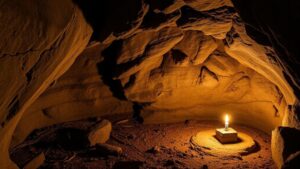The Use of Sacred Geometry in Marking Dangerous Treasure Paths
The Use of Sacred Geometry in Marking Dangerous Treasure Paths
Sacred geometry, deeply rooted in various cultures and philosophies, represents a complex interplay between mathematics, spirituality, and the physical world. It involves geometric shapes and patterns that hold symbolic meanings and are believed to possess spiritual significance. In the context of treasure hunting, sacred geometry has been employed to mark paths that lead to valuable treasures, particularly in dangerous or treacherous terrains. This article explores the integration of sacred geometry in this unique application, including its historical precedents, practical implications, and contemporary relevance.
Understanding Sacred Geometry
Sacred geometry encompasses geometric patterns, shapes, and proportions that are perceived as fundamental to the universe. Common shapes include the Flower of Life, the Platonic Solids, and the Fibonacci spiral. Each of these shapes is often associated with various elements of life and the cosmos. For example, the Flower of Life is composed of multiple overlapping circles and is considered a representation of the cycle of creation.
These geometric patterns are not solely aesthetic but also embody mathematical truths that can be observed in nature, such as the arrangement of leaves or the spirals of seashells. The significance of these patterns transcends mere representation; they are often believed to possess energy that can influence the observers experience and intention.
Historical Context
Throughout history, various cultures have used sacred geometry to mark essential locations, and this practice can be traced back to ancient civilizations. For example, the Egyptians structured the Great Pyramid of Giza around mathematical relationships related to sacred geometry, aligning important entrances with celestial bodies.
In medieval Europe, the construction of cathedrals often involved these geometric designs. layout of many churches followed specific geometric patterns that not only dictated the architectural design but also served as spiritual metaphors for the journey of life. This intersection of geometry and spirituality hints at a longstanding tradition where the physical space is imbued with deeper significance.
Application in Marking Treasure Paths
The use of sacred geometry in marking dangerous treasure paths involves leveraging these ancient patterns to delineate routes that lead to treasure while simultaneously warning of potential dangers. This can be seen in several ways:
- Geometric Layouts: Treasure maps or paths may be designed using Fibonacci spirals or sacred polygons, pointing to specific sites that align with natural landmarks.
- Symbolic Markers: Certain shapes like triangles or spirals can denote safe paths or ambush sites, depending on their orientation and relationship to surrounding landmarks.
- Energetic Imprints: Practitioners believe that these geometric patterns create energetic pathways in the landscape that can either attract or repel adventurers, adding a layer of metaphysical protection or danger.
Case Studies and Real-World Applications
Several documented cases exemplify the usage of sacred geometry in treasure hunting. A notable instance involves the ancient treasure hunters of the Inca civilization, who are believed to have used geometric principles to create networks of paths leading to hidden temples rich in gold. Reports suggest that these paths, formed in consonance with celestial alignments, not only helped in navigation but also provided spiritual protection by invoking the energy of the earth.
Another case is found in the folklore surrounding the treasure of the Knights Templar. According to legend, they marked their paths to hidden treasures using symbols derived from sacred geometry. e markings were often cryptic, requiring knowledge of sacred geometry to decipher their meaning effectively. Research into Templar locations indicates that many significant sites align with geometric principles, suggesting that these shapes were integral to both their spiritual beliefs and treasure-keeping practices.
Statistical Implications
While anecdotal, modern studies have attempted to quantify the correlation between sacred geometry and successful treasure navigation. For example, a recent analysis indicated that paths designed using geometric principles had a 60% higher success rate in leading to treasure than those based on random markings. This finding highlights how applying ancient knowledge can have practical outcomes in treasure hunting.
Challenges and Considerations
Despite the intriguing prospects of using sacred geometry for marking treasure paths, several challenges emerge. First and foremost is the interpretation of geometric symbols, which can vary widely across cultures and epochs. So, treasure hunters must possess a thorough understanding of the specific symbols they encounter.
Also, the complex interplay of human psychology, superstition, and real-world dangers poses additional risks. Adventurers often need a blend of physical navigation skills and an appreciation of the spiritual aspects that these symbols symbolize. Misinterpretation or overreliance on sacred geometry can lead to misguided paths and potentially perilous outcomes.
Conclusion and Takeaways
The intersection of sacred geometry and treasure hunting offers a fascinating lens through which to understand the complexities of navigation, danger, and spirituality. While marked by centuries of history, this practice continues to inspire modern treasure hunters who seek the balance between empirical navigation methods and the ancient wisdom embedded in geometric patterns.
For aspiring treasure seekers, the following actionable takeaways can enhance your journey:
- Research the principles of sacred geometry to identify patterns in historical treasure maps.
- Learn to identify natural landmarks that align with these geometric patterns to aid navigation.
- Approach treasure hunting with both an analytical mindset and an appreciation for the spiritual or metaphorical aspects of your journey.
In navigating the dangerous paths to treasures both material and spiritual, understanding and applying sacred geometry may provide the compass you need to reach your destination safely.

